When it comes to citrus fruits, few are as popular and beloved as tangerines and oranges. These vibrant fruits are not only delicious but also packed with essential nutrients. In this blog, we will delve into the world of tangerines vs. oranges, exploring their key differences in taste, appearance, nutritional value, and more. By the end of this article, you’ll have a deeper understanding of these citrus wonders, helping you make informed choices the next time you reach for a juicy snack or a glass of fresh-squeezed juice.
Tangerine vs Orange
What is a Tangerine?
Tangerines, with their sweet and tangy flavor, have a fascinating history rooted in Florida, USA. In the 1800s, these citrus gems acquired their name “tangerine” because they were introduced to the United States through the port city of Tangier in Morocco. From a botanical perspective, tangerines belong to the C. tangerina species and are closely related to oranges, both being citrus family members.
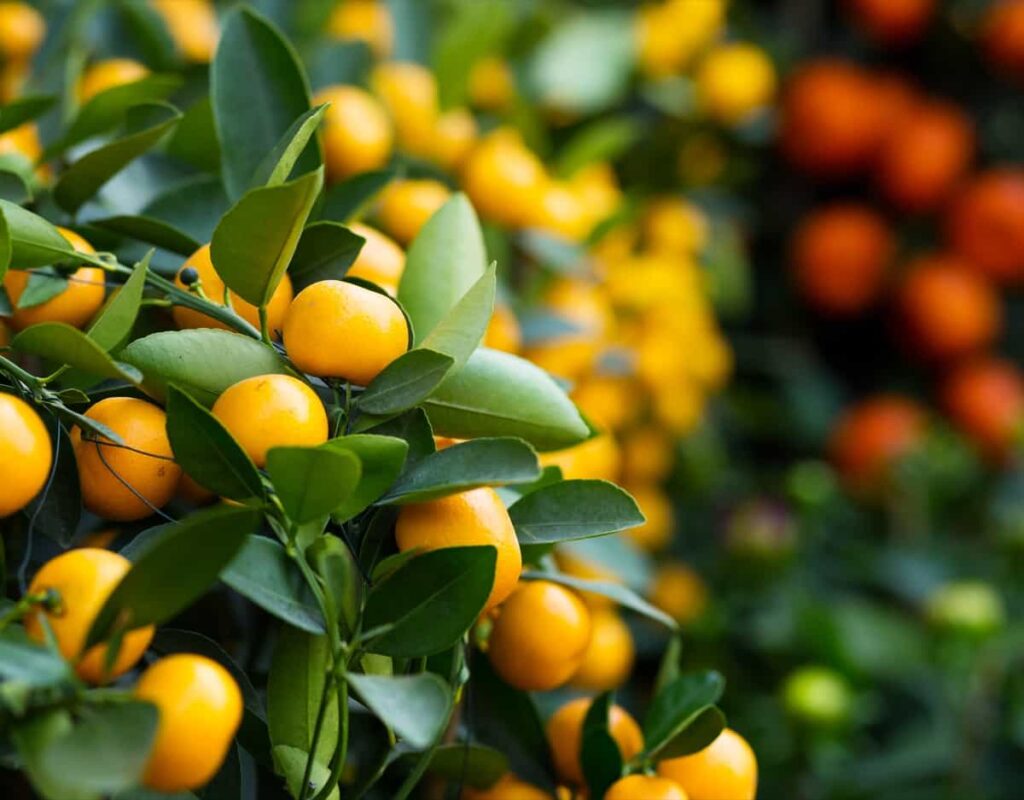
However, there is a common mislabeling of tangerines and mandarins, especially in the United States. Strictly speaking, tangerines are a subgroup of mandarins, typically distinguished by their vibrant reddish-orange hue. The best time to savor the juicy delight of tangerines is from late October through January, when they are in their prime. These small, easy-to-peel fruits satisfy your taste buds and offer essential nutrients, making them a delightful and healthy snack option during winter.
What are Oranges?
Oranges, the citrus darlings we all know and love, have an extensive history of their origins in Asia, particularly Southern China and Indonesia. Today, the bulk of orange production occurs in two major regions: Florida and Sao Paulo, Brazil. Botanically speaking, oranges belong to the Citrus x sinensis species, firmly establishing their place within the citrus family. What intrigues oranges is their hybrid nature, born from the union of pomelo and mandarin fruits.
- Common or round: This class encompasses various orange varieties, including Valencia, Hamlin, and Gardner, primarily cultivated for their juice production.
- Navel: Perhaps the most recognizable class, navel oranges earn their name due to a second fruit at their base resembling a human belly button. Cara cara is a renowned member of this class.
- Blood or pigmented: These oranges boast a distinctive dark red flesh thanks to their high concentrations of anthocyanin, an antioxidant pigment. Occasionally, the rind may exhibit darker red spots.
- Acidless or sweet: This class is characterized by its exceptionally low acid levels, making these oranges a delightful treat for direct consumption rather than juice production.
- The peak season for oranges varies depending on the variety, but as a general rule, you can expect most oranges to be at their prime from November through March.
In case you missed it: Optimizing Sweet Orange Orchard Management: A Month-By-Month Operation Guide for Maximum Yield

Taxonomy and Classification of Tangerine and Orange
Tangerine (Citrus reticulata)
- Tangerines belong to the species Citrus reticulata.
- They are a subgroup of mandarins, typically reddish-orange.
- Tangerines originated in Florida and got their name from the Moroccan city of Tangier.
In case you missed it: Plum Fruit Orchard Management: A Comprehensive Month-wise Maintenance Guide
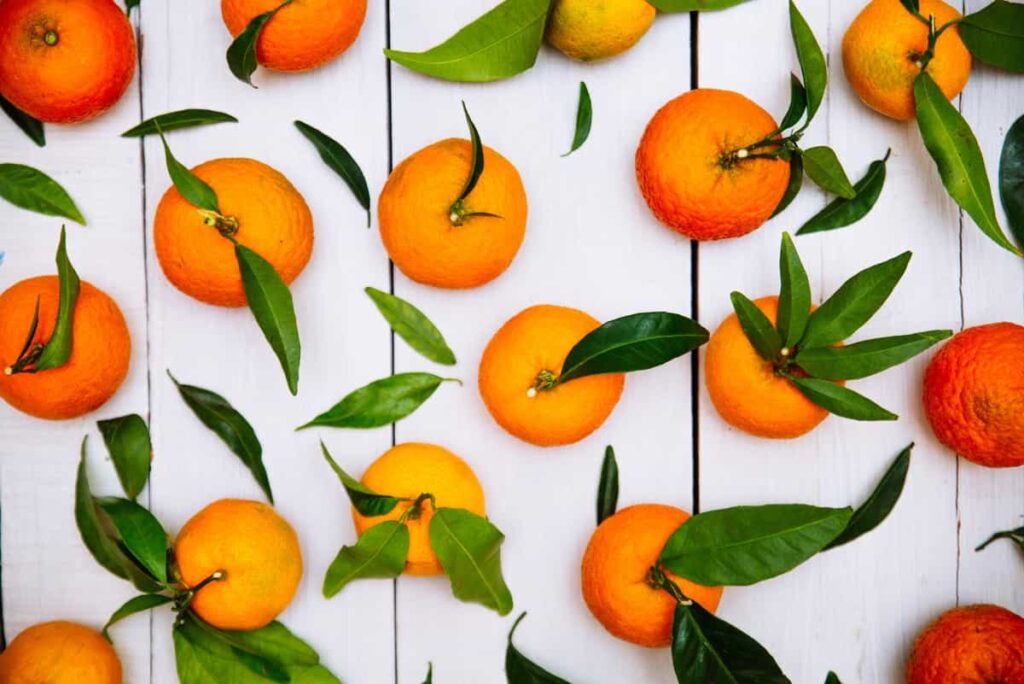
Orange (Citrus x sinensis)
- Oranges are members of the species Citrus x sinensis.
- They are hybrid fruits resulting from the crossbreeding of pomelo and mandarin.
- Oranges have four main classes: common, navel, blood, and acidless.
- Common oranges, like Valencia, are often used for juice production.
- Navel oranges have a second fruit at the base resembling a navel.
- Blood oranges have a distinct dark red flesh due to high anthocyanin content.
- Acidless oranges are low in acid and are mainly eaten rather than used for juice.
Physical Appearance and Size Comparison
Tangerines are smaller, brightly colored fruits with a thin, loose skin that makes them easy to peel. They are round or flattened, and their flesh is juicy and sweet. Oranges, on the other hand, are larger, ranging from medium to large, with thick, textured skin that can be harder to peel. They are round and can be substantial, requiring two hands to hold. The skin of an orange is thicker and adheres more tightly to the fruit. The flesh of an orange can vary in sweetness, with some varieties being more tart.
Varieties and Cultivars of Tangerine and Orange
Varieties and Cultivars of Tangerine
- Clementine: Clementines are small and seedless tangerines known for their sweet, easy-to-peel nature. They are a favorite for snacking.
- Satsuma: Satsumas are another seedless variety with loose skin. They are easy to peel and have a slightly tangy-sweet flavor.
- Dancy: Dancy tangerines have a rich, sweet flavor but may contain seeds. They are often used for juice production.
Varieties and Cultivars of Orange
- Valencia: Valencia oranges are excellent for juicing due to their sweet, juicy flesh. They are a popular choice for fresh orange juice.
- Navel: Navel oranges are easily recognizable by the small second fruit at the blossom end. They are sweet and perfect for fresh eating.
- Blood: Blood oranges, with their deep red flesh, offer a unique flavor profile and are often used in desserts and specialty beverages.
- Cara Cara: These navel oranges have pinkish-red flesh and a sweeter taste than traditional navels.
- Seville: Seville oranges are bitter and used primarily for making marmalade and other preserves.
In case you missed it: 20 Best Fruit Rootstock Nurseries in the USA: List for Buying Rootstock for Grafting
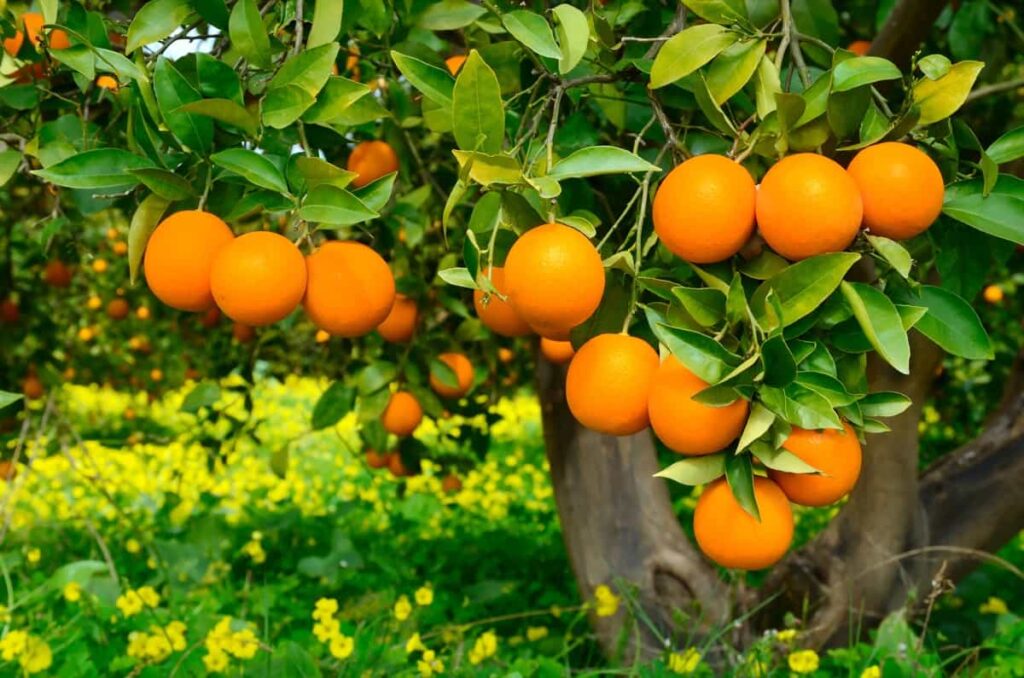
Nutritional Composition and Health Benefits
- Tangerines and oranges share a remarkably similar nutrient composition. They both have high water content (85-87%) and are predominantly composed of carbohydrates (around 4% of daily value). Both fruits are virtually fat-free.
- In a 3.5-ounce (100-gram) portion:
- Tangerines contain 53 calories, 13.3 grams of carbs, 1.8 grams of fiber, 0.8 grams of protein, and 0.3 grams of fat.
- Oranges contain 47 calories, 11.7 grams of carbs, 2.4 grams of fiber, 1.0 grams of protein, and 0.1 grams of fat.
- Oranges, however, excel in vitamin C content, providing 89% of the daily value compared to tangerines’ 44%. Vitamin C is vital for supporting connective tissues and overall health.
- Oranges also offer slightly more dietary fiber, enhancing their status as an excellent source of this beneficial carbohydrate.
- Tangerines shine in vitamin A content, providing 14% of the daily value, while oranges offer 4%. Vitamin A is for vision and skin health.
- Both fruits supply essential nutrients like potassium, thiamin, and folate, contributing to their nutritional value.
Flavor Profile and Taste Differences
Tangerines and oranges exhibit distinct flavor profiles. Tangerines are known for their sweet and tangy taste and hint of tartness. Their flavor often carries floral and citrusy notes, making them a delightful balance of sweet and zesty. Oranges, on the other hand, tend to be sweeter with a milder tang, and their taste is often described as bright and refreshing. They have a sweeter, more straightforward citrus flavor than tangerines’ complex sweetness and tanginess.
Citrus Family: Similarities and Distinctions
- Shape: Oranges are typically round and nearly perfectly circular, whereas tangerines have a slightly flattened appearance while retaining a round shape.
- Peel Texture: The peel of an orange is generally smooth with few crevices or pits, making it relatively easy to peel. In contrast, tangerine peels are rough, with numerous small crevices, making them more challenging to peel cleanly.
- Texture: Oranges maintain a firm texture even when fully ripe, while tangerines are softer to the touch and tend to become even softer with time.
- Acidity: Oranges tend to have a higher pH level, which makes them slightly more acidic than tangerines. This difference attributed to the larger size of oranges.
- Seeds: In their natural state, oranges can be found with and without seeds. On the other hand, tangerines traditionally come with seeds, but seedless tangerines have been developed with the aid of technology.
Geographic Distribution and Cultivation
Tangerines
- Tangerines are native to Southeast Asia, particularly China. They were introduced to the United States in the 1800s and are now widely cultivated in Florida and California. Other regions like Spain, Morocco, and Japan also grow tangerines.
- Tangerines thrive in subtropical and tropical climates with well-drained, sandy soils. They require warm temperatures and moderate rainfall for optimal growth.
- Varieties like Clementine and Satsuma are well-suited to regions with shorter growing seasons and cooler temperatures, making them adaptable to various climates.
In case you missed it: 15 Best Varieties of Dragon Fruit: DifferentTypes of Dragon Fruit (Pitaya) to Grow
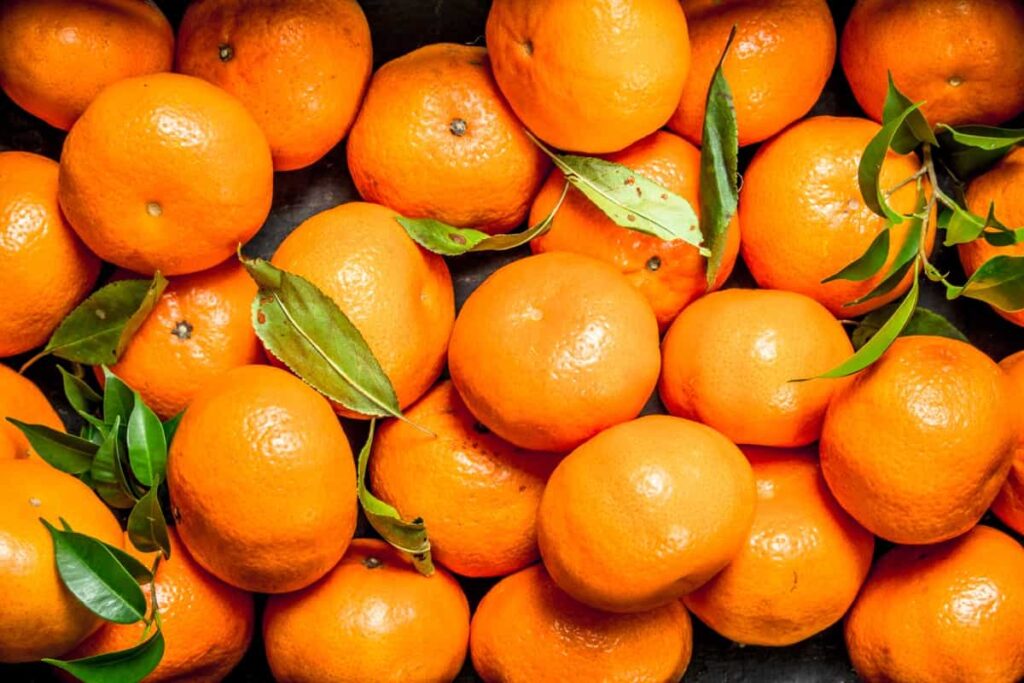
Oranges
- Oranges have a broader global presence and are cultivated in numerous countries worldwide. The largest producers include Brazil, the United States (particularly Florida and California), and China.
- Oranges are adaptable to various climates, from Mediterranean regions to tropical and subtropical zones.
- Cultivated varieties like Valencia and Navel have specific characteristics that make them ideal for fresh consumption or juice production, catering to different market demands.
Harvesting Seasons and Availability
Tangerines: Tangerines are typically in season during the late fall and winter months, specifically from late October through January. This period marks their peak availability and highest quality. In regions like Florida, tangerines are harvested primarily from November to January. Exact timing can vary depending on the specific variety and local climate conditions. They are often enjoyed as a seasonal winter treat, making them a refreshing addition to the cold-weather diet.
Oranges: Oranges have a more extended harvesting season compared to tangerines. They are generally available from late fall through early spring, starting from November and lasting into April in many regions. Valencia oranges, known for their late-season availability, are typically harvested from March to June. This prolonged season allows consumers to enjoy fresh oranges and their juices throughout the winter and early spring months, making them a staple citrus fruit in many households worldwide.
In case you missed it: How to Germinate Seeds: Techniques for Faster Germination of Vegetables, Flowers, Fruits, and Herbs
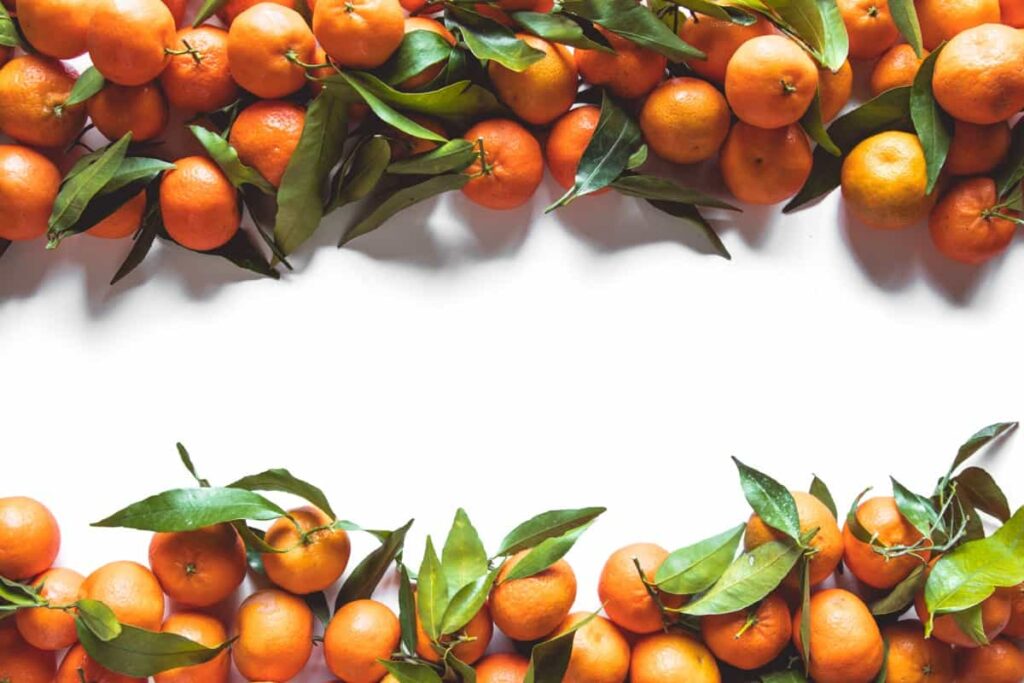
Culinary Uses and Recipes for Tangerine and Orange
Tangerines add a sweet, tangy kick to sweet and savory dishes. Their segments make for delightful snacks and garnishes in salads. Tangerine zest and juice enhance desserts like cakes and puddings. Try a tangerine glaze for poultry or seafood for a citrusy flavor.
Recipe: Tangerine Chicken Stir-Fry – Sauté chicken with tangerine juice, soy sauce, and ginger. Add vegetables, then serve over rice for a zesty stir-fry.
Oranges are versatile and commonly enjoyed fresh, juiced, or zested. They make refreshing fruit salads, marmalades, and salad dressings. Orange zest elevates baked goods, while their juice creates vibrant sauces for meats and desserts.
Recipe: Orange Glazed Salmon – Brush salmon fillets with orange glaze (made with orange juice, honey, and soy sauce) and bake for a deliciously sweet and savory meal.
Juice Production and Commercial Applications
Their sweet, tangy flavors make them ideal candidates for commercial juice production. With their unique taste, tangerines are often blended with other citrus fruits for a distinct flavor profile. Oranges, on the other hand, are a staple in the global juice industry, with varieties like Valencia prized for their juiciness.
These juices find application in a wide range of products, including bottled juices, concentrates, smoothies, and cocktails. Additionally, the zest and peel of both fruits are used to extract essential oils for flavoring beverages, confectionery, and various culinary applications.
Medicinal Properties and Traditional Uses
Tangerines and oranges are renowned for their medicinal properties and traditional uses. Both fruits are rich in vitamin C, boosting immunity and wound healing. Their antioxidants combat free radicals, reducing the risk of chronic diseases. Traditionally, their peels have been used for digestive relief and as aromatherapy for stress reduction.
Oranges are associated with heart health due to their potassium and folate content. Tangerines, in traditional Chinese medicine, alleviate symptoms of coughs and colds. The citrus compounds in both fruits have been studied for their potential anti-inflammatory and anticancer properties, highlighting their importance in holistic health.
Essential Oils Extraction from Tangerine and Orange
Essential oils from tangerine and orange are extracted from their peels, which are rich in aromatic compounds. The extraction process involves cold-pressing or steam distillation. Tangerine essential oil is valued for its sweet, citrusy aroma, often used in aromatherapy for stress relief and mood enhancement.
Orange oil has a bright, uplifting scent and is commonly used in perfumery, cleaning products, and as a flavoring agent. Both oils contain terpenes like limonene, which have potential health benefits and anti-inflammatory and antimicrobial properties.
Economic Importance and Market Demand
Tangerines and oranges are vital to the global fruit industry, with oranges being the most widely cultivated and generating significant revenue and employment opportunities in regions like Florida, California, and Brazil. Despite being smaller, tangerines are valued for their unique flavor and seasonal availability, contributing to the diversity of the citrus market. Both fruits meet consumer demand for fresh, healthy, and vitamin-rich citrus products.
Conclusion
While tangerines and oranges share similarities to citrus fruits, they differ in flavor, appearance, and nutrient content. Tangerines offer a tangy complexity, while oranges provide a sweeter simplicity, catering to diverse preferences and culinary uses.
- How to Raise Pigs in Your Own Backyard: A Comprehensive Guide
- Budget Friendly Sheep Shed Ideas: Cheap and Low-Cost Tips
- How Much Do Cattle Farmers Make: Revenue Streams in Cattle Farming
- Management Pests and Diseases in Your Cotton Field
- Sheep Farming Business Plan for Beginners
- Aquaponic Farming at Home: A Step-By-Step Guide
- Profitable Village Farming Business Ideas in 2024
- High-Yield Aquaculture: Fast-Growing Fish for Farming
- Effective Fish Pond Construction Techniques for Beginners
- Irrigation and Water Management in Pineapple Farming
- Blossom to Harvest: Mastering Flowering and Pollination in Papaya Farming
- Pig Fattening Essentials: From Selection to Sale for Beginners
- Raising Wagyu Cattle: A Complete Guide for Premium Beef Production
- Soil Types and Their Water Holding Capacity
- Optimizing Irrigation Schedules for Coconut Groves for Enhanced Yield
- Espresso Your Garden: Coffee Grounds for Healthier Acid-Loving Plants
- The Best Soil Mix for Snake Plants: How to Mix Your Own Snake Plant Soil
- Green Thumb Success: Expert Tips for Cultivating Greenhouse Beans All Year Round
- Bloom All Year Round: The Ultimate Guide to Indoor Hyacinth Care
- Eco-Friendly Gardening: How to Make Liquid Fertilizer from Kitchen Waste
- Ultimate Guide to Grow Anise in Pots: Explore Seed Propagation to Harvesting
- Guide to Raising Chester White Pigs: Discover Breed Facts to Growth Management
- Mastering the Elegance: The Ultimate Guide to Weeping Cherry Tree Care, Planting, and Maintenance
- Ultimate Guide to Planting Garlic in Grow Bags: Growing Strategies for Beginners
- How to Fix Spider Plant Leaf-Related Problems: Natural and Organic Remedies
- 10 Reasons Why Your Tulsi Plant is Shedding Leaves: Home Remedies and Solutions
- Optimizing Growth and Yield: The Advantages of Palm Bunch Ash Fertilizer
- Utilizing Neem Oil Extract as a Natural Pesticide for Hydrangea
- From Soil to Harvest: Various Ways in Which Farmers Can Use AI Tools
- Steps to Encourage and Induce Citrus Flowers: A Comprehensive Guide
- How to Fix Snake Plant Leaf-Related Issues: Natural and Organic Remedies
- Transform Your Garden into a Fragrant Oasis with Raat Ki Rani (Night Blooming Jasmine)
- Discover the Ideal Chicken Breeds for Philippine Farms
- How to Create a Poultry Egg Farm Business Plan for Profits
- Grow Lemon Cucumbers Like a Pro: Insider Techniques for Bountiful Yields
- Ultimate Guide to Caring for Your Pink Princess Philodendron: Tips for Thriving Variegation
